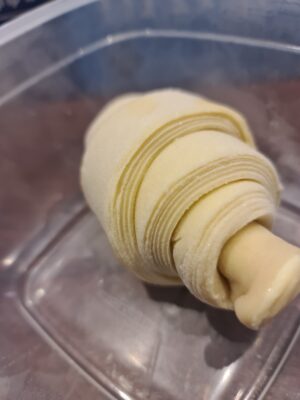Scoolinary › Forums › Ask a question › The problem in the final product of the croissant
-
The problem in the final product of the croissant
Posted by mh_shaheen23 on February 28, 2024 at 12:29Hello
Regarding chef Antonio’s method for making croissants, I did do all the steps according to the chef’s explanation. Despite this, I got a bad result in the baking phase – bad browsing level in the Crousson, medium and very small volume. It is worth noting that this is the second time I have encountered this problem. In my opinion, the reason for the problem is because the chef said that after the kneading step, the dough should be put directly in the freezer for 24 hours, in order to preserve the aroma of the butter. Therefore, it makes the rising and baking stage difficult. It is worth noting that I used a different method and it worked, that is, after kneading I let the dough rest at room temperature and then I put the dough in the refrigerator for 24 hours and not in the freezer.
Furthermore, during the baking phase, a large amount of butter liquefies on the baking shelf
Thank you and I would be happy for a professional and detailed explanationSussan Estela Olaya replied 1 year, 9 months ago 3 Members · 6 Replies -
6 Replies
-
Level:
Scoolinary Team
Hi @mh_shaheen23 👋
I’ll bring @sussan_scoolinaryteam to this thread so she can give us her opinion on your doubt.
Have a great day, and keep on trying with those 🥐 I’m sure you’ll get a hold on them soon.
-
Level:
Scoolinary Team
Hi Shaheen
Making a light croissant at home is not easy, but it is worth a try. It will be difficult, although not impossible, to achieve the same result as that of a good professional baker.
Butter croissants are famous for their delicate, flaky texture, as well as their irresistible buttery flavor. This recipe requires time and skill as it involves multiple folds and layers of butter. Key tricks include keeping ingredients and dough cold, working quickly, and baking at high temperatures for a perfectly golden and crispy result.
Part of the main problems with a croissant not coming out is incorrect stretching and rolling of the dough.
It seems that the internal part of your croissant is poorly stretched and has not fermented the same, hence that layer that looks like unwrapped dough, you must be very careful with the fermentation times as well as with the cooking.
The dough must be worked cold. No choice. If you try it with heat, the butter will leak around the edges and you won’t get the flaky effect you’re looking for.
Solution:
-When you see that the butter begins to soften, put it in the refrigerator.
-Cool the butter: Before using it, it is important that the butter is cold, but not frozen. This way it will be easier to handle and will not melt as quickly when baking the croissants.
-Stretch the dough: Once the dough is prepared, it is important to stretch it enough so that it has a uniform thickness and can completely envelop the butter. If the dough is too thin, the butter will easily come out when baking.
-Do not press the dough too much, this will prevent the layers from being defined and during cooking and it will not become flaky.
-Fold the dough: To prevent the butter from escaping, it is important to fold the dough several times during the croissant making process. This will help the butter stay completely closed and not leak out when baking.
Bake at the right temperature: It’s important to bake croissants at the right temperature, so they cook evenly and the butter doesn’t melt too quickly. It is recommended to bake them at a temperature between 180 and 200 degrees Celsius.
We hope this information is useful.
Greetings.
-
-
Level:
Scoolinary Team
Hi, @mh_shaheen23
Your laminate looks great, but there are many factors that can cause the croissant to not develop, from the flour, the type or state of the yeast, the fermentation time and temperature, the lamination temperature, the oven temperature. It is enough for one of these to fail for us to not be successful with the final product. Remember that this is a course with high difficulty and the only way to have better results is to practice.
Greetings.
-
-
Thank you very much and once again thank you for the encouragement and support I hope to succeed in the end
-
Level:
Scoolinary Team
Hi Shaheen
If you have any other questions or concerns regarding the courses, you can ask them here and we will be happy to help you resolve them.
Greetings.
-
The forum ‘Ask a question’ is closed to new discussions and replies.




